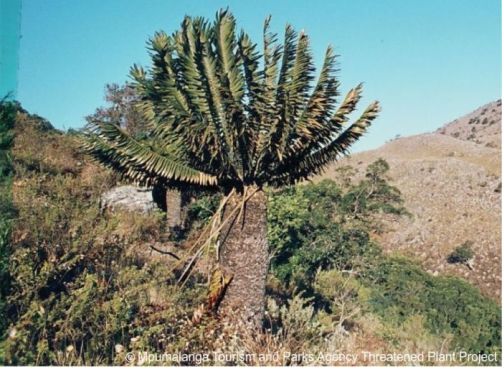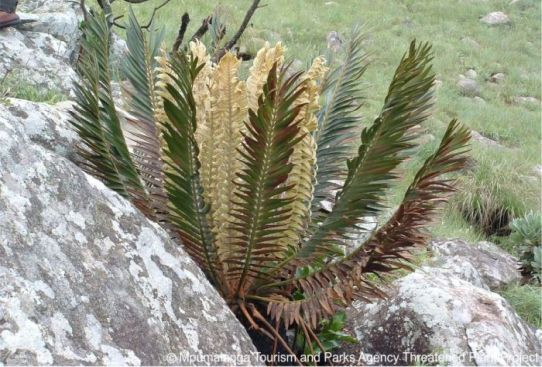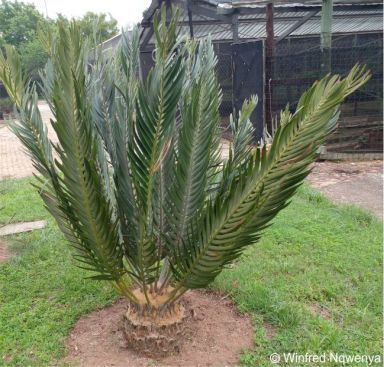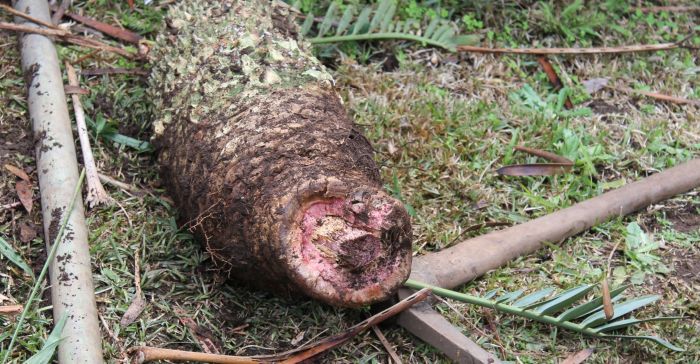Encephalartos heenanii
Encephalartos heenanii R.A.Dyer
Family: Zamiaceae
Common names: woolly cycad (Eng.), wollerige broodboom (Afr.)
SA Tree No: 14.1
Introduction
Encephalartos heenanii is a medium-sized cycad with an erect stem that may become procumbent with age. This cycad is commonly known as the woolly cycad because it produces a thick, woolly layer below the crown of leaves, on the apical part of the caudex. This is a rare cycad that is on the brink of extinction in the wild.

Description
Description
Encephalartos heenanii has an unbranched, erect, single aerial stem up to 3 m long and 300 mm in diameter. Mature plants can produce basal suckers. The stem crown is covered by a golden brown woolly layer.
Leaves are medium-sized, about 1–1.5 m long, held upright, rachis is incurved and often slightly twisted at the apex, giving a wine-glass-like appearance to the plant. Two forms are recognized, unofficially, namely the ‘short-leaf form’ and the ‘long leaf form’. The juvenile leaves in both forms are bluish, due to the presence of the golden brown hairy outer layer, which gradually disappears but not completely, even when the leaf is mature. Mature leaves are dark green on the upper surface and lighter green on the underside. The leaves of the ‘short-leaf form’ are 0.95–1.05 m long and those of the ‘long leaf form’ are 1.25–1.76 m long. Median leaflets are 120–150 mm long and about 15 mm wide in the ‘short leaf form’, in the ‘long leaf form’ they are 200–300 mm long and 20 mm wide. Leaflets are leathery, and have numerous nodules on the upper side and prominently raised veins on the underside. Leaflet margins are usually entire or have 1 or 2 teeth and are not thickened. Basal leaflets do not reduce to a series of spines. Petiole is 220–290 mm long and covered with golden brown wool.

Both genders produce 1 to 3 cones per season, very similar when immature. Cones are light green, however the colour is obscured by a layer of dense brown wool which decreases in mature male cones but is permanent in the female cones. Male cones are 270–300 mm in diameter, 150–170 mm long, with a 90 mm long peduncle, which is obscured by the golden brown wool of the stem apex. Pollen shedding takes place in winter (June to August). Female cones are 230–300 mm long, 170–180 mm in diameter, with a 60 mm long peduncle but is completely covered by the woolly hair of the stem apex. The female cone disintegrates in summer (December to February). Seeds are bright red, 55 mm long, 32 mm in diameter.
Conservation Status
Status
According to the Red List of South African plants website, Encephalartos heenanii is assessed as Critically Endangered (CR). Records indicate that the remaining population size is estimated to be less than 400 mature individuals in the wild, and their numbers continue to decline. A few scattered groups of about 20 mature individuals remain in adjacent areas in Eswatini. This cycad is on the brink of extinction in its natural habitat, due to illegal poaching of wild plants for private collections and habitat destruction as a result of the planting of pine plantations which have stopped the occurrence of regular veld fires which stimulate coning. Furthermore this species is a slow grower, that does not reproduce frequently in nature and was never abundant.

Distribution and habitat
Distribution description
Encephalartos heenanii is found in Barberton, Mpumalanga, and in Eswatini. It grows in open areas, among grasses, on steep slopes and in forest margins at about 1 500 m altitude. The climate is hot in summer and cold in winter. The habitat receives a rainfall of about 1 200 per annum, mainly in summer.
Derivation of name and historical aspects
History
The genus Encephalartos was described by the German botanist Johann Georg Christian Lehmann in 1834. The epithet is derived from Greek and means ‘bread in head’ and refers to the floury, starchy material in the trunks of some species, which is used as famine food by local people.
This species was described in 1972 by botanist Robert Allen Dyer. The epithet honours Denis Heenan, who brought the plants to the attention of the South African National Biodiversity Institute in Pretoria (formerly known as Botanical Research Institute). Denis Heenan and his son David were the first people to notice this cycad in 1969. Initially there were no fresh cones and the remains of the cones were severely damaged by insects. In this location there are other cycads growing closely to each other, namely Encephalartos paucidentatus and E. laevifolius. At that time the assumption was that E. heenanii was a natural hybrid between these two species growing next to each other. In 1971 new evidence in the form of fresh new cones was collected and it was described a new species (Dyer 1972).
Cycads are grouped into 3 families: Cycadaceae, Stangeriaceae and Zamiaceae. Currently there are about 343 species of cycad recognized worldwide. Cycads are found in the tropical, subtropical and warm temperate regions of Africa, Asia, Australia, and North and Central America. South Africa has the most cycad species in Africa, with 38 species in the genus Encephalartos, of the family Zamiaceae, and 1 species of Stangeria. South Africa also has the most threatened species: 3 species are Extinct in the Wild (EW) and 12 species have been listed as Critically Endangered (CR), and likely to soon be extinct in the wild.
Encephalartos heenanii hybridizes with E. paucidentatus in areas where these two species share a habitat. Some anecdotal reports suggest that the ‘long leaf form’ of E. heenanii might be progeny of a natural hybrid between E. paucidentatus and the ‘short leaf form’ of E. heenanii (Grobbelaar 2002).
This species is closely related to and often confused with Encephalartos transvenosus and E. paucidentatus. They can be distinguished as follows:
E. transvenosus leaflets do not have prominent longitudinal ridges on the underside.
E. paucidentatus leaves are usually either straight or downward curving, leaflet margin is dentate and basal leaflet is reduced to several spines. The leaves of the ‘short leaf form’ of E. heenanii are also much shorter that those of E. paucidentatus.

Ecology
Ecology
In the past, this cycad occurred in grasslands that were subjected to regular fires, however surviving species are mostly growing within pine plantations from which fires are excluded. Just like other grassland cycads, fires play a very important role in stimulating coneing in this plant.
For a long time it was thought that all cycads were wind pollinated, as most coniferous plants are, and the fact that cycads generally produce high volumes of pollen, supported this argument. However, objections were raised based on the following points: species such as E. cycadifolius, E. ghellinckii, E. heenanii, E. friderici-guilielmi and E. lanatus have very woolly cones, which make it difficult for wind pollination to happen. Other cycad species such as E. villosus and Stangeria eriopus occur in forest where there is no wind. Current research shows that insects are the pollinators of all 10 cycad genera. Most cycads are thermogenic (able to produce heat) and emit volatile odours. In nature when the male cone reaches maturity, the central axis elongates and the scales move apart to make room for the release of the pollen, which is distributed by insects. The release of pollen varies between species but usually lasts for 2 weeks, on average. At the same time, the female cone also reaches maturity, the cone heats up, causing it to elongate, and it produces a smell, which attracts the insects, the pollen vectors, to the female cone. The scales move apart to allow the insects to enter and to pollinate the cone.

Uses
Use
In isiZulu language, most of the cycads are referred to as isqgiki–somkhovu. This name refers to witchcraft practices, where a person is converted into becoming a zombie and is used for witchcraft. The cycad is planted in front of the gate of the homestead to protect it from the evil spirit. If someone practices any witchcraft using umkhovu, this zombie will sit on top of the cycad, which is referred as isqgiki, which means ‘chair’, and that is where the common name is derived from.
This species has become common in private collections, but the occurrence of the wild species has declined so much, that this species can be considered to be on brink of extinction and its continued existence is uncertain. The decline of this species is partly because plants cone infrequently and it was never abundant. Therefore obtaining seeds and seedlings is difficult and expensive.

Growing Encephalartos heenanii
Grow
Encephalartos heenanii is grows best in light shade or full sunlight and is frost tolerant. This species is a slow grower.
Encephalartos heenanii is propagated by seed and suckers. Sow seed in river sand and place on a heated bench at 24–28°C. Germination should start 4–6 weeks after sowing. However, some seeds will take longer, especially where there is no heat. This cycad does not transplant well and as a result, mature plants may die in the process.
When a sucker reaches a size of about 80 mm diameter, dig the soil away from around the main cycad to expose the sucker and clean any dirt from the sucker and the main cycad. Use a sharp, clean, cutting tool, such as a saw, chisel or knife, to cut off the sucker. Make a clean cut at the point of attachment of the sucker to the main plant. As a precaution, especially with valuable species, apply fungicide, sulphur or a tree seal to the cut area, on both the sucker and the mother plant, to prevent disease and attacks by pests.
If the sucker is large enough (minimum of 250 mm) and it has enough roots, it is best to immediately plant it straight into the ground. Smaller suckers and suckers with no roots of their own must be taken to the nursery, where they should be left in a cool, dry area to dry for a few weeks, to allow the wounds to form a callus, before potting.
Plants in the natural habitat have been are reported to be susceptible to the caterpillar of the leopard moth.
References
- Donaldson, J.S. 2009. Encephalartos heenanii R.A.Dyer. National Assessment: Red List of South African Plants version 2020.1. Accessed on 2021/11/23
- Dyer, R.A. 1972. A new species of Encephalartos from Swaziland. Bothalia 10(4):539–546.
- Goode, D. 2001. Cycads of Africa. Cycads of Africa Publishers, Gallomanor.
- Grobbelaar, N. 2002. Cycads with special reference to the southern African species. Published by the author, Pretoria.
- Jones, D.L. 1993. Cycads of the world: Ancient plants in today's landscape. Reed, New South Wales.
- Ulwazi, sharing indigenous knowledge. Isihlahla sesigqiki somkhovu. https://www.ulwaziprogramme.org/2016/10/isihlahla-sesigqiki-somkhovu/ Accessed on 2019/04/26.
Credits
Lungisani Zondi
Walter Sisulu National Botanical Garden
January 2022
Acknowledgements: the author thanks Winfred Ngwenya and H.F. Glen for images of Encephalartos heenanii growing in the Lowveld National Botanical Garden, and the Mpumalanga Tourism and Parks Agency Threatened Plants Project for images of Encephalartos heenanii growing in habitat.
Plant Attributes:
Plant Type: Shrub, Tree
SA Distribution: Mpumalanga
Soil type: Loam
Flowering season:
PH:
Flower colour:
Aspect: Full Sun, Morning Sun (Semi Shade), Afternoon Sun (Semi Shade)
Gardening skill: Average
Special Features:
Horticultural zones









Rate this article
Article well written and informative
Rate this plant
Is this an interesting plant?
Login to add your Comment
Back to topNot registered yet? Click here to register.